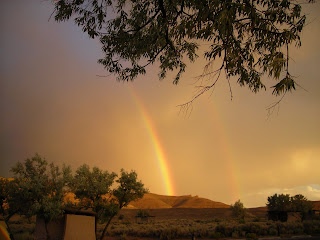It seems that he pondered a great deal, and with alarmingly radical daring,
over that triangular striated marking in the slate; reading into it certain
contradictions in Nature and geological period which whetted his curiosity to
the utmost, and made him avid to sink more borings and blasting's in the
west-stretching formations to which the exhumed fragments belonged. He was
strangely convinced that the marking was the print of some bulky, unknown, and
radically unclassifiable organism of considerable advanced evolution,
notwithstanding that the rock which bore it was of so vastly ancient a date -
Cambrian if note actually pre-Cambrian-as to preclude the probable existence not
only of highly evolved life, but of any life at all above the unicellular or at
most trilobite stage. These fragments, with their odd marking, must have been
500 million to a thousand million years old.
H.P. Lovecraft, At The Mountains of Madness (1936)
Halloween is as good a time as any to reflect on the intersection between science (and, specifically, GEOLOGY) and Weird Fiction. One of my favorite Weird Authors has to be H.P. Lovecraft who, along with others like Robert E. Howard, Fritz Leiber, and Frank Belknap Long, transcended (sometimes) the simple medium of pulp horror and ushered in the modern age of science fiction. The quote above is from one of Lovecraft's most famous works, At The Mountains of Madness, and is one of my favorites for the very selfish reason that plot really hinges around geology. An online copy of the story is available here. It makes some good geo-Halloween reading!
First and foremost, the story is narrated by one Prof. Dyer, a professor of geology at the fictional Miskatonic University, in the fictional town of Arkham, Massachusetts, who is heading a scientific expedition to the Antarctic (set in the early 1910's); once there, they plan to take drill cores and sample the geology of the region. He's accompanied by other academics from the university, as well as graduate students. Already, it's a story near and dear to my heart.
Once in the frozen wastes of the Antarctica, the scientists' hopes of amazing discoveries are quickly realized; using the drill, they find many samples of fossils, including strange, ancient TRACE FOSSILS that no one can quite figure out. The quote at the head of this post is taken from the work, and is talking about these unusual triangular features. Interestingly, the geologist, Dyer, must be a sedimentologist, since he initially attributes the features to slightly metamorphosed "ripple effects". That's a good lesson, I think; always make the ichnologist convince YOU of the critter-origins for any weird marks.
Anyway, the biologist on the team apparently gets excited about these trace fossils, and as the quote above shows, draws some daring conclusions (spooooky conclusions, mind you) about what could have caused them. The search for the specific stratigraphic horizon on which these traces are found becomes the main focus of the expedition, who strike deeper and deeper into the unknown heart of Antarctica, and the increasingly more ancient mountains and strata that they discover.
Eventually, the biologist and some of the grads, who are pursuing the traces while Dyer and his students are doing other work (probably mapping...or drinking. They are geologists, after all), come across some "Comanchian" aged strata that host some cave deposits. Now, you and I probably have never heard of the Comanchian period, which was supposed to be between the Jurassic and Cretaceous periods, and was subsequently abandoned by the 1930's. However, since Lovecraft set the story in the Early 1900's, the geologists would still be using the term. Lovecraft, who was a very devoted lover of science, took special pains to make this story as scientifically valid (for its day) as he could, so it is actually an interesting historical document in that regard.
Anyway, within these caves, the biologists come across many fossils, of seemingly jumbled chronology, as well as huge, barrel-like "fossils" of an unknown, crinoid-like creatures, bigger than a human. They take these crinoid-creatures back to camp, where it turns out the Things may have some relation to the strange trace fossils found earlier. Oh, and they may not be quite so dead yet, either...
Lovecraft had a flair for the horrible and the weird, and took particular delight in how odd sea life was. A scholar of Lovecraft's life and work, S.T. Joshi, has made particular study of some of the influences on ol' Lovecraft (mostly using his 10,000+ letters that he wrote in his life), and has found that he had in mind for his crinoid-like Elder Things a particular Plate from the work of Ernst Haeckel. Below is the figure: Plate 90 from Haeckel's Kunstformen der Natur:

These crinoid Elder Things, with their alien physiognomy, also have another of Lovecraft's characteristic "horrible" attributes: incredible ancientness. Lovecraft commonly used the concept of Deep Time in his work, citing incredibly ancient things from the dawn of the universe, and describing how our minds could scarcely wrap our brains around such cosmically significant gulfs of time and space. Too, Lovecraft accurately describes the graduate student experience: as you dive deeper into your branch of Forbidden Knowledge, the Creeping Insanity starts to take hold...
If you have the time, At The Mountains of Madness is a fun read. It has a geologist as the main character, uses all sorts of archaic geological and stratigraphic terms, centers around horrible space crinoids (and their trace fossils), and even has a little bit about Continental Drift, which Lovecraft supported at a time when most American workers thought it was nonsense. Plus, there are some genuinely creepy parts (blind albino penguins...and, oh God! Shoggoths!) which might make for a fun Halloween.


























